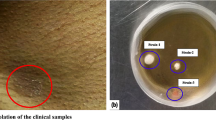Abstract
Background
The causes of seborrheic dermatitis (SD) are complex and incompletely understood. Among the factors, Malassezia yeasts have been reported to play a major etiological role in SD. Many previous studies adopted conventional culture methods that were disadvantaged to detect Malassezia microflora in SD patients, resulting in a low detection rate for each species and high variance in types of microflora observed.
Objective
This study analyzed Malassezia microflora in SD patients by applying a transparent dressing to the lesional skin and using direct detection of fungal DNA using nested PCR.
Methods
We collected samples from the lesional skin of 146 SD patients in China and extracted fungal DNA directly from the lesional samples without culture. Specific primers for each Malassezia species were designed to amplify existing yeasts in each sample. Some samples were randomly selected to culture and identified by morphological and physiologic criteria.
Results
M. globosa and M. restricta were found in 87.0 and 81.5 % of seborrheic dermatitis patients, respectively, which together accounted for more than 50 % of Malassezia spp. recovered in these Chinese patients. The majority of SD patients (82.9 %) showed co-colonization of two or more Malassezia species.
Conclusion
M. globosa and M. restricta predominated in Malassezia colonization in Chinese SD patients. Compared with conventional culture, non-culture-based methods may more accurately reflect Malassezia microflora constitution.


Similar content being viewed by others
References
Gerd P, Thomas J. Seborrheic dermatitis. In: Wolff K, Goldsmith LA, Katz SI, Gilchrest BA, Paller AS, Leffell DJ, editors. Fitzpatrick’s dermatology in general medicine. 7th ed. New York: McGraw-Hill; 2008. p. 1822–30.
Naldi L, Rebora A. Clinical practice. Seborrheic dermatitis. N Engl J Med. 2009;360:387–96.
Ro BI, Dawson TL. The role of sebaceous gland activity and scalp microfloral metabolism in the etiology of seborrheic dermatitis and dandruff. J Investig Dermatol Symp Proc. 2005;10:194–7.
Crespo EV, Delgado FV. Malassezia species in skin disease. Curr Opin Infect Dis. 2002;15:133–42.
Nakabayashi A, Sei Y, Guillot J. Identification of Malassezia species isolated from patients with seborrheic dermatitis, atopic dermatitis, pityriasis versicolor and normal subjects. Med Mycol. 2000;38:337–41.
Gupta AK, Kohli Y, Summerbell RC, Faergemann J. Quantitative culture of Malassezia species from different body sites of individuals with or without dermatoses. Med Mycol. 2001;39:243–51.
Falk SMH, Linder MT, Johansson C, Bartosik J, Back O, Sarnhult T, Wahlgren CF, Scheynius A, Faergemann J. The prevalence of Malassezia yeasts in patients with atopic dermatitis, seborrhoeic dermatitis and healthy controls. Acta Derm Venereol. 2005;85:17–23.
Sugita T, Suto H, Unno T, Tsuboi R, Ogawa H, Shinoda T, Nishikawa A. Molecular analysis of Malassezia microflora on the skin of atopic dermatitis patients and healthy subjects. J Clin Microbiol. 2001;39:3486–90.
Sugita T, Tajima M, Tsubuku H, Tsuboi R, Nishikawa A. Quantitative analysis of cutaneous Malassezia in atopic dermatitis patients using real-time PCR. Microbiol Immunol. 2006;50:549–52.
Sugita T, Tajima M, Amaya M, Tsuboi R, Nishikawa A. Genotype analysis of Malassezia restricta as the major cutaneous flora in patients with atopic dermatitis and healthy subjects. Microbiol Immunol. 2004;48:755–9.
Sugita T, Suzuki M, Goto S, Nishikawa A, Hiruma M, Yamazaki T, Makimura K. Quantitative analysis of the cutaneous Malassezia microbiota in 770 healthy Japanese by age and gender using a real-time PCR assay. Med Mycol. 2010;48:229–33.
Gemmer CM, DeAngelis YM, Theelen B, Boekhout T, Dawson TL Jr. Fast, noninvasive method for molecular detection and differentiation of Malassezia yeast species on human skin and application of the method to dandruff microbiology. J Clin Microbiol. 2002;40:3350–7.
Xu J, Saunders CW, Hu P, et al. Dandruff-associated Malassezia genomes reveal convergent and divergent virulence traits shared with plant and human fungal pathogens. Proc Natl Acad Sci U S A. 2007;104:18730–5.
DeAngelis YM, Gemmer CM, Kaczvinsky JR, Kenneally DC, Schwartz JR, Dawson TL Jr. Three etiologic facets of dandruff and seborrheic dermatitis: Malassezia fungi, sebaceous lipids, and individual sensitivity. J Investig Dermatol Symp Proc. 2005;10:295–7.
Piérard-Franchimont C, Xhauflaire-Uhoda E, Piérard GE. Revisiting dandruff. Int J Cosmet Sci. 2006;28:311–8.
Aspiroz C, Moreno LA, Rezusta A, Rubio C. Differentiation of three biotypes of Malassezia species on human normal skin: correspondence with M. globosa, M. sympodialis and M. restricta. Mycopathologia. 1999;145:69–74.
Tajima M, Sugita T, Nishikawa A, et al. Molecular analysis of Malassezia microflora in seborrheic dermatitis patients: comparison with other diseases and healthy subjects. J Invest Dermatol. 2008;128:345–51.
Prohic A, Kasumagic-Halilovic E. Identification of Malassezia species from immunocompetent and immunocompromised patients with seborrheic dermatitis. Eur Rev Med Pharmacol Sci. 2010;14:1019–23.
Lee YW, Byun HJ, Kim BJ, et al. Distribution of Malassezia species on the scalp in Korean seborrheic dermatitis patients. Ann Dermatol. 2011;23:156–61.
Oh BH, Lee YW, Choe YB, Ahn KJ. Epidemiologic study of Malassezia yeasts in seborrheic dermatitis patients by the analysis of 26S rDNA PCR-RFLP. Ann Dermatol. 2010;22:149–55.
Crespo EV, Ojeda MAA, Vera CA, Crespo EA, Sánchez FF. Isolation and identification of Malassezia spp. In pytiriasis versicolor, seborrheic dermatitis and healthy skin. Rev Iberoam Micol. 1999;16:S16–21.
Gaitanis G, Velegraki A, Alexopoulos EC, Chasapi V, Tsigonia A, Katsambas A. Distribution of Malassezia species in pityriasis versicolor and seborrhoeic dermatitis in Greece. Typing of the major pityriasis versicolor isolate M. globosa. Br J Dermatol. 2006;154:854–9.
Acknowledgments
This work was funded by Project 31100020 and 30570095 of the National Natural Science Foundation of China and supported in part by research grants from Department of Health of Sichuan Province (100141) and scientific research project of North Sichuan Medical College (MP-ZK-34).
Conflict of interest
None.
Author information
Authors and Affiliations
Corresponding author
Rights and permissions
About this article
Cite this article
Zhang, H., Ran, Y., Xie, Z. et al. Identification of Malassezia Species in Patients with Seborrheic Dermatitis in China. Mycopathologia 175, 83–89 (2013). https://doi.org/10.1007/s11046-012-9606-z
Received:
Accepted:
Published:
Issue Date:
DOI: https://doi.org/10.1007/s11046-012-9606-z




